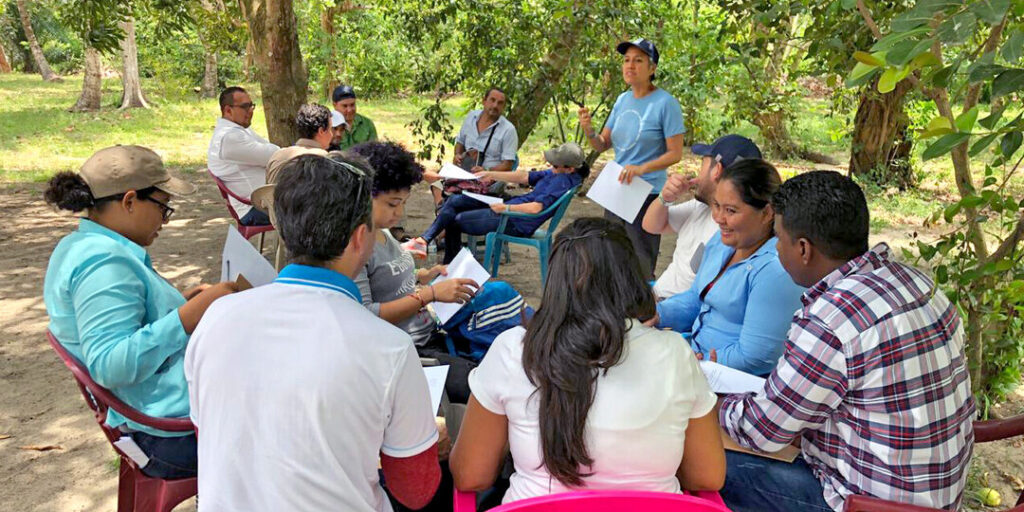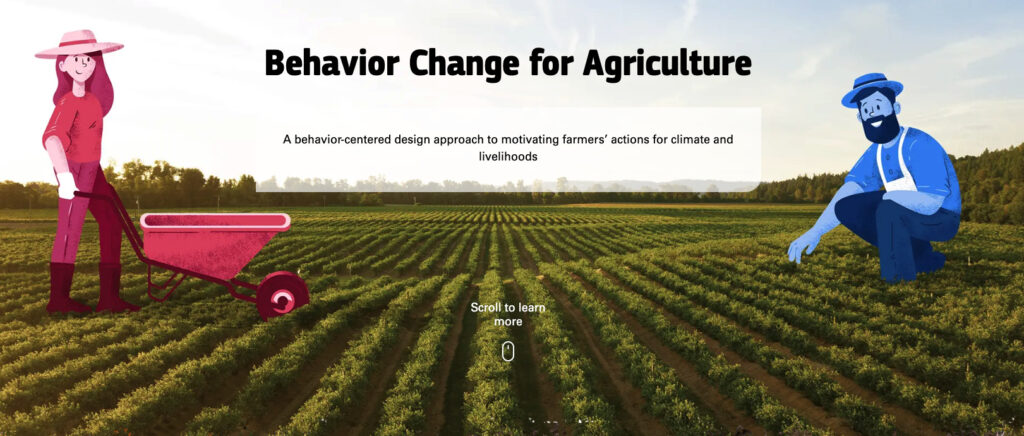People are responsible for today’s major environmental problems: deforestation, overfishing, ocean plastics, and climate change. But people are also the solution. Understanding our behaviors can help us understand each other and improve our relationship with nature.
Through Rare’s Center for Behavior & the Environment, we connect research and insights from behavioral and social sciences and design thinking to the people on the frontlines of our most urgent environmental challenges. Our growing understanding of human behavior and decision-making holds tremendous promise for inspiring the behavior change necessary to conserve nature and provide for the communities who depend on it.
Below, we explore the topic of behavior change for nature to illustrate why and how behavioral and social science can help solve environmental challenges.
Why do we need behavior change?
What is human behavior?
What does conservation have to do with behavior change?
How do we change behaviors?
What are social norms?
What is the science of human behavior?
What are behavioral insights?
What are the building blocks of behavior change?
Rare and behavior change for nature.
What is behavior-centered design for the environment?
How can behavior-centered design help solve cooperative dilemmas?
What are behavioral solutions to climate change?
What are behavioral solutions to agriculture?
The ethics of behavior change.
Why do we need behavior change?
Protecting nature ultimately comes down to people and their behaviors toward the planet. What links nearly all present environmental problems is their root cause: human behavior (Foley et al., 2005; IPCC, 2018). To address these challenges, humans must act differently (Schultz, 2011). In other words, most environmental challenges (and certainly most of those within our capacity to solve) are behavioral challenges, and environmental solutions must also be behavioral solutions.
» Habitat destruction, climate change, ocean acidification, resource depletion, and wildlife trafficking, among others, are examples of significant hairy environmental challenges with behavioral underpinnings. Addressing them, e.g., by reducing wildlife trafficking, helping individuals adopt a plant-rich diet, and convincing artisanal fishermen to catch less today so they may end up getting more tomorrow, is more effective when we address peoples’ underlying motivations for doing an unsustainable behavior and the barriers to adopting a different behavior.

What does conservation have to do with behavior change?
Conservation is fundamentally about changing human behavior (Ehrlich & Kennedy, 2005; Schultz, 2011). In one way or another, conservationists are often trying to help natural resource users adopt more sustainable behaviors and practices. Conservationists have always been in the business of behavior change, though this is only recently becoming recognized as fundamental to the sector.
There is a growing recognition in the conservation field that adopting more responsible and sustainable behaviors and practices is critical for achieving environmental outcomes (Cinner, 2018; Balmford et al., 2021; Nielsen et al., 2021). Human behavior change can mitigate environmental threats and deliver sustainable conservation and socioeconomic results. Given the right conditions and incentives, we can achieve and sustain substantive change in human resource use behavior.
Whether or not all environmental problems can be resolved by changing human behavior, an effective conservation project must adequately address human behavior.
Organizational change, community change, societal change, and global change begin with individual behavior change. Balmford and Cowling (2006) note that “conservation is primarily not about biology but about people and the choices they make.” Conservation is thus a social and biological undertaking – requiring solutions founded in behavior change that strengthen the relationship between people and nature.
How do we change behaviors?
Adopting new behaviors is a process. Human behavior is complex, unpredictable, and context-dependent.
To understand behavior change, we must first acknowledge two opposing systems in our brains: the rational, analytical, problem-solving side and the emotional, socially-embedded side. For example, our rational side may understand the need to reduce carbon emissions. However, our emotional side ignores climate change if reducing emissions means we should avoid driving or flying places (and use public transportation instead). Our emotional side is often much more powerful.
A fundamental belief at Rare is that individuals and groups are motivated as much by emotion as reason. As such, our behavior-centered work strives to identify and appeal to both the rational and emotional drivers of behavior change, connecting with both the head and the heart.
Behavior change is best achieved by first motivating individuals to want to change their behaviors; in other words, by making a new behavior personally and socially desirable. Through our work, we seek to change prevailing knowledge and attitudes about an issue (e.g., unsustainable agriculture), its threat (e.g., chemical fertilizers), and the associated behaviors (e.g., use compost instead) as a first step toward motivating behavior change.
We must further remove the key barriers that block or hinder a person and their community from accepting a new behavior. Financial, political, technical, or other barriers may prevent a new behavior or reduce the speed at which an individual or target audience accepts it. Proactively understanding and removing these barriers is critical to initial and sustained behavioral adoption.
Adopting a new behavior within a community or social group is a process of diffusion in which different individuals adopt a targeted behavior at different times; it’s not a one-off occurrence in which all individuals simultaneously accept and implement the targeted behavior. Such ‘diffusion of innovations’ theory demonstrates that distinct types of subgroups have varying propensities toward change and explains how, why, and at what rate new ideas and technologies spread through a culture. In the diffusion process, there is a point at which an innovation reaches critical mass, and the new behavior becomes an embedded social norm.
A new behavior is more likely to be adopted and sustained if it becomes a new “social norm” and is supported and enforced by the wider community. Importantly, people generally adopt a significant new behavior only after they have validated it with their peers – interpersonal communication is essential to behavior change.
Throughout its history, Rare has used innovators, positive deviants, and trusted sources as examples for others to follow until new behaviors become entrenched social norms.
What are social norms?
Whether you’re new to behavioral science or an expert in the field, you’ve almost certainly heard about norms. Norms are socially-enforced rules or expectations. [Building Blocks: What’s in a norm?] Personal norms guide our behavior through our belief systems. Social norms guide individual behavior through the ways other people think and act.
Social norms are unwritten, group-held beliefs and rules of behavior about how members behave (and should behave) in a given context, group, or society. They include traditions, customs, and group rules and values. We all undoubtedly experience them: at home, at work, at school, in public places, and on the internet. Examples from Western culture include forming a line at store counters, saying ‘bless you’ when someone sneezes or holding the door for someone.
Social norms, cognitive biases, emotions, social networks, and decision-making environments impact our behaviors and choices. Norms not only detail what is appropriate behavior, but they define what a group does and who the group is. Identity is formed by group norms and by conforming to them.
Individuals instinctively take behavioral cues from their social groups. Norms tell us what people do (i.e., eat a lot of meat), what they should do (i.e., eat more vegetables), and what they shouldn’t do (i.e., overeat red meat). Social norms have been the basis of various impactful behavior change interventions in various domains.

What is the science of human behavior?
The science of human behavior combines two disciplines: behavioral science and social science.
Behavioral science focuses on understanding an individual’s psychological state. Social science focuses on understanding an individual’s sociocultural context. Both disciplines are necessary for understanding someone’s behavior within a given context. While the two disciplines may appear quite different, they both aim to explain human behavior and interaction.
Behavioral science: While definitions of behavioral science vary, we focus on the systematic study of human judgment and decision-making. This research has been conducted by those working in several fields but is most associated with psychology and behavioral economics. This perspective considers an individual the central unit for analyzing and understanding behavior.
Social Science: While there is no single definition, it’s essentially the study of the relationship between social structure and decision-making. The fields most associated with this research include anthropology, sociology, political science, and human geography. This perspective recognizes that individuals do not make their decisions in a vacuum. Instead, social science puts social structure into primary focus. This includes how that social structure defines an individual’s social identities and roles and how their actions can feed back into shaping the social structure for themselves and the network in which they are embedded. From this perspective, this feedback system of socially defined identities and roles creates the foundation for individuals to make choices (Popitz, 1972).
These disciplines can best be understood in the context of a spectrum. This spectrum ranges from the most cognitive explanations of decisions within an individual (their abilities to think and reason as opposed to feeling) to the most abstract descriptions of social interaction focused solely on the system in which those individuals are embedded. Many sub-disciplines exist closer to the middle of this spectrum and blend these two perspectives, e.g., social psychology, cultural psychology, cognitive anthropology, and network analysis. We can use these complementary perspectives to understand existing behavior change interventions designed to address global environmental challenges, such as biodiversity conservation, climate mitigation, water management and conservation, waste management, and land management.
By embracing this entire spectrum of the science of human behavior, we better understand human behavior as a whole. A revolution in the science of human behavior over the past few decades has changed how we think about how people make decisions. It has revealed a new and growing set of insights that can aid us in designing behavioral solutions that work for everyday people, from fishers and farmers to tourists to government officials. These insights highlight that we must change our assumptions about our target audiences. Our choices are not made solely based on fully conscious, deliberate, or even rational information processing. We are emotional, embedded in social networks, and influenced by the context of decisions and how choices are presented.
What are behavioral insights?
Behavioral insights are observations of human behavior. They concern how people perceive things, how they make decisions, and how they behave. We can apply behavioral insights to address environmental challenges, and they can help practitioners, policymakers, and other stakeholders design more effective environmental programs, interventions, and policies.
Due to the wealth of information about human behavior, we have a tremendous opportunity to apply these insights and transform conservation threats into real-world solutions. While behavioral insights may not hold all the answers, we know they are crucial to making behavior change happen in the short and long term.
What are the building blocks of behavior change?
There are many ways to understand the motivations and barriers to helping individuals adopt new behaviors. Rare’s Center for Behavior & the Environment has created a behavior change framework comprised of six behavioral ‘levers’ that practitioners can ‘pull’ to support behavior change. Each lever represents a category of intervention strategies based on evidence-based principles and behavioral and social science case studies. The levers are discrete and can be pulled in different combinations for different effects.
Historically, within conservation, there have been three main levers that policymakers and environmental practitioners have pulled: shifting material incentives, enacting rules and regulations, and providing information to individuals. While these traditional levers can successfully help individuals adopt new behaviors, they have also been well-documented as generally insufficient for changing behavior independently (Cinner, 2018).
Environmental behavior change program designers have recently expanded their toolkit to include a more comprehensive set of levers for shifting behavior and achieving environmental outcomes. In addition to the traditional levers, Rare’s behavior-centered design framework now includes choice architecture, emotional appeals, and social influences.
 |
Choice Architecture: Using choice architecture means constructing an individual’s choice environment (the environment in which they make choices) without changing the value of one’s underlying options. This lever deviates from the more traditional levers by not assuming that people are solely influenced by their rational deliberation but also by how a choice is presented to them. There are many ways in which a designer might construct the choice environment. These include prominent strategies such as directing attention by increasing salient features or changing what outcome occurs by default, using timely moments to prompt action, and providing decision aids that encourage short- or long-term decision-making. Example: A GPS suggests the best/fastest route, but you can choose any route. |
 |
Emotional Appeals: Emotional appeals function differently by changing how an individual feels about a set of options. Humans like to believe that they deliberate over all their decisions, yet emotions often drive our decisions. In their peer-reviewed Ecology & Society article, the Center for Behavior & the Environment’s Katie Williamson and Erik Thulin explore why harnessing people’s emotions is a central but undervalued tool for helping people adopt more sustainable behaviors. Emotional appeals can include messaging that makes the behavior feel consistent with the target individual’s core identities and values or encourage the individual to experience a particular emotion that results in a particular behavioral pattern. Example: Pride prompts people to show others what they have done when they have engaged in reputation-enhancing behavior. Anger pushes people to confront others when they experience or witness something against their values. Both can play influential roles in encouraging positive change. |
 |
Social Influences: Humans are social beings; therefore, our decisions depend highly on those around us. This includes our willingness to cooperate, conform, and change due to social pressure or following the lead of those we like or admire. These social influences can be passive, without intent (e.g., a child adopts a parent’s beliefs or values), or active (see example below). Leveraging an individual’s social networks and influences is an effective behavior change strategy. Social influence strategies involve understanding how an individual relates to others in their social system, including those with power and prestige, and leveraging these dynamics to support changes in their behavior. Changing behavior in this way often includes social learning, making behavior more observable, or shifting social norms by changing an individual’s expectations for what others in their reference network are doing or think is right or wrong. Example: A local celebrity or government official signs a public pledge to do something, encouraging others to add their signatures. |
 |
Material incentives: Shifting material incentives involves increasing or decreasing the costs, time, or effort for doing a behavior. This lever has its roots in neoclassical economics, where an individual is assumed to respond to only the material incentives for engaging or not engaging in a specific behavior. Standard methods for shifting incentives include enforcing penalties for non-compliance with rules, providing rewards for positive behavior, or making a target behavior materially easier, such as removing time friction or promoting substitute actions. Example: A local organization hands out reusable bags to reduce single-use plastics. |
 |
Rules and Regulations: Passing rules and regulations that promote or restrict a behavior is perhaps the most commonly used strategy for achieving environmental outcomes. Rules and material incentives (e.g., laws and penalties) often work together, but each can exist without the other. For example, a seller might offer an incentive to purchase a product without any legal requirement. Similarly, laws and rules can be passed without their enforcement shifting the material incentives. Even without enforcement, rules can shift behavior due to people having a general preference to conform to rules even without positive or negative sanctions (Funk, 2007) or where rules convey factual or social information (Sunstein, 1996). Example: Following a law requiring fishers to respect lobster size limits. |
 |
Information: Providing individuals with information has also been a common tactic in traditional environmental programming, including explaining what the desired behavior is, why it is essential, and how to engage in it. Informational programs implicitly assume something similar to the information deficit model; the lack of change in someone’s behavior is assumed to be because they do not know critical information, rather than psychological or socio-contextual factors (Burgess et al., 1998). Studies have shown that simply attaining knowledge may encourage some individuals to change their behavior. However, for most individuals, only receiving information is a necessary but insufficient tool to foster behavior change. |
Rare and behavior change for nature
Among environmental and conservation programs, there remains an immense need to apply behavioral insights to develop effective approaches and spotlight what solutions are already being deployed at a small scale around the world. Identifying these solutions, creating a detailed evidence base of their effectiveness, and providing support to organizations speeding up their global adoption are critical if we are to address the most pressing global environmental challenges—especially those exacerbated by human consumption of natural resources.
Rare’s Center for Behavior & the Environment exists to bring behavioral tools to environmental changemakers worldwide. In 2017, Rare launched the BE.Center, for short, to bring the best insights from behavioral science and design to tackle globally significant and ‘wicked’ environmental challenges. The BE.Center is the world’s first center dedicated exclusively to behavioral science and design for the environment. With a diverse team of world-class behavioral and social scientists, designers, and trainers, the BE.Center guides changemakers in designing behavior-centered environmental solutions. We help them understand and address the motivations, barriers, and social context of the actors whose behavior needs to change and design appropriate solutions.
The BE.Center also collaborates with Rare’s program staff and partners to design and deliver behavioral solutions to a range of initiatives tackling individual and household greenhouse gas emissions, overfishing, unsustainable land use, conservation crime, water pollution, and the emergence of zoonotic diseases. Our solutions draw from best-in-class research and Rare’s field-based experience. Rare’s programs include Fish Forever, Lands for Life, and Climate Culture.
While most environmental organizations have a deep bench of expertise in physical science, they don’t often have equal know-how in the science of behavior change. To address this, the BE.Center offers hands-on training, freely available tools and resources, original research, and engaging in-person and virtual events to build changemakers’ capacity to design behavior-centered solutions. We’re also growing an online network of practitioners and building direct partnerships with NGOs, businesses, and philanthropic institutions that want to design better solutions with the science of human behavior.
As a conservation organization working with local communities worldwide, Rare focuses on centering local communities and their leaders in conservation decision-making and management and supporting them to make and own decisions related to their natural resources. To do this, we facilitate community-led natural resource management and ground our work in the needs and priorities of those closest to their natural resources.
That means we spend significant time in the field to immerse ourselves in the local experience and learn about community members’ day-to-day lives. Qualitative research and co-designing solutions with community members are integral to developing the correct behavior change strategy and supporting a conservation solution’s durability. Rare is known for this collaborative and community-led approach to conservation.
» Learn more about Rare’s Center for Behavior & the Environment.
What is behavior-centered design for the environment?
Behavior-centered design is Rare’s approach that blends insights from behavioral science and approaches from design thinking to build breakthrough solutions to environmental challenges.
Behavior-centered design for the environment is a series of steps that can help practitioners and organizations apply behavioral science, create innovative solutions, and lead interventions to protect people and nature. The eight steps of this design journey include framing an environmental challenge, gaining empathy with a target audience, connecting research data to behavioral insights, ideation, prototyping, and measuring the success of a behavioral intervention. It supports understanding the levers of behavior change for designing environmental solutions. of change.
» Learn more about behavior-centered design for the environment and the steps of a design journey.
How can behavior-centered design help solve cooperative dilemmas?
Cooperative dilemmas are common in conservation. What is best for the individual is different than what is best for the group. So then how can environmental leaders change these destructive behaviors? Rare’s Center for Behavior & the Environment (BE.Center) released the Theory of Cooperative Behavior Adoption Guide to help practitioners design effective solutions to tackle these cooperative challenges.
Take overfishing. Each individual fisher does better catching as many fish as they can. But when all fishers fish this way, it depletes the fishery to such an extent that the remaining fish cannot replace those that were lost fast enough, and the system collapses. Although on the surface it may appear different, that exact same dynamic is at play when we consider air pollution from cars. Individually, each driver does well driving their car as much as they would like, as their emissions have rather little effect on them directly. But in many cities, the combined effect of such overwhelming emission levels are undermining the health of the entire community.
As difficult as these problems seem, they are not insurmountable. Recent research in the behavioral sciences has revealed a series of key beliefs that, when changed, can move a community to act cooperatively. By combining these insights from research and the experience of environmental practitioners, Rare developed the three-phase Theory of Cooperative Behavior Adoption for shifting groups and communities to these cooperative outcomes.
» Watch the BE.Center’s Behavioral Science Lead, Dr. Erik Thulin, present the theory of Cooperative Behavior Adoption at TEDxCambridge Salon.
» Download the related guide
What are behavioral solutions to climate change?
Lessening the worst of climate impacts requires a substantial push to limit global temperature changes over the course of this century. This in turn depends on humankind’s ability to achieve rapid and sustained reductions in greenhouse gas emissions over the next several decades. Doing so demands a transformation of our economy and our systems of production and consumption, from changing how we generate energy and produce food to how we consume goods and services.
While the focus for most of this change often rests at the scale of government and industry, changes at the level of individuals, households, and communities are of profoundly greater importance than most people appreciate. Nearly two-thirds of global emissions are linked to both direct and indirect forms of human consumption; despite what the headlines suggest, even conservative estimates for the potential of changing behaviors to reduce natural resource consumption represent an enormous contribution to reducing global emissions.
Achieving this potential, however, is a daunting challenge. It requires finding innovative ways of engaging individuals, households, and communities, and changing patterns of production and consumption that are ingrained in routine ways of life. The movement to mitigate climate change has tended to rely heavily on categories of solutions that include sweeping global policy reform, offsets and economic incentives to influence industry, and information-based messaging. Without a doubt, each of these is an important component to the worldwide effort to stop global warming. But we know that people are more complicated than the narrow solutions we often design to influence them.
As individuals, people often report feeling hopeless that they can effect change on a scale that matters for something as big as climate change. But individual behavior change, when taken up by billions of people, makes a decisive difference.
» To learn more, visit Rare’s Climate Culture program or read Rare’s Climate Change Needs Behavior Change report.

What are behavioral solutions to agriculture?
See Rare’s Behavior Change for Agriculture Guide, which showcases a behavior-centered design approach to motivating farmers’ actions for climate and livelihoods.
The Ethics of Behavior Change
Behavior change practitioners seeking to realize a social good must pay attention to ethics. Ethics are particularly relevant to a program that uses persuasion to influence a target audience and achieve its goals. Therefore, we encourage practitioners to adhere to the following principles:
Particular intervention strategies may target different kinds of well-being, and we cannot expect all forms of well-being to be equally pursued at all times. Even so, following the principle of well-being means that our work should always entail the goal of helping humans and nature flourish.
At no time should conservation advocates misrepresent facts or people’s ideas, even if they disagree. Nor should advocates misrepresent the intentions and consequences of particular environmental policies or instances of management. Finally, conservation practitioners should not deceive or manipulate people in ways that cause them to do behavior they do not want to or remove their agency or free will.
Whenever possible, behavior change interventions should support citizens to make democratic decisions about conservation, such as through environmental policy and management. To do this, interventions should strive to make the best scientific, political, economic, and moral arguments available to the public.
There is a rich body of literature on the ethics of behavior change, and nudging strategies in particular, which often embrace non-conscious forms of influence. We cannot do this literature justice here and direct interested readers to resources such as Cass Sunstein’s The Ethics of Influence. Such literature demonstrates how behavioral science sheds new light on the nature of agency and personal choice. In practice, influence is unavoidable, as we are constantly being nudged towards confident choices by aspects of our environment, whether done with intent or not.
The ethical influencer, therefore, seeks to ensure their influence is for good rather than for profit or personal agenda; that their influence leads to improved decisions on the target audience’s terms; and freedom of choice is not restricted unless justified to reduce harms committed to others (as with restricted freedoms through environmental laws, for example). We encourage you to explore what ethical influence means to you in your work and use our principles as helpful guidelines.
Related Content
Stay Connected
Sign me up for occasional emails to learn more about Rare’s work and how I can support its mission.
You can unsubscribe at any time.